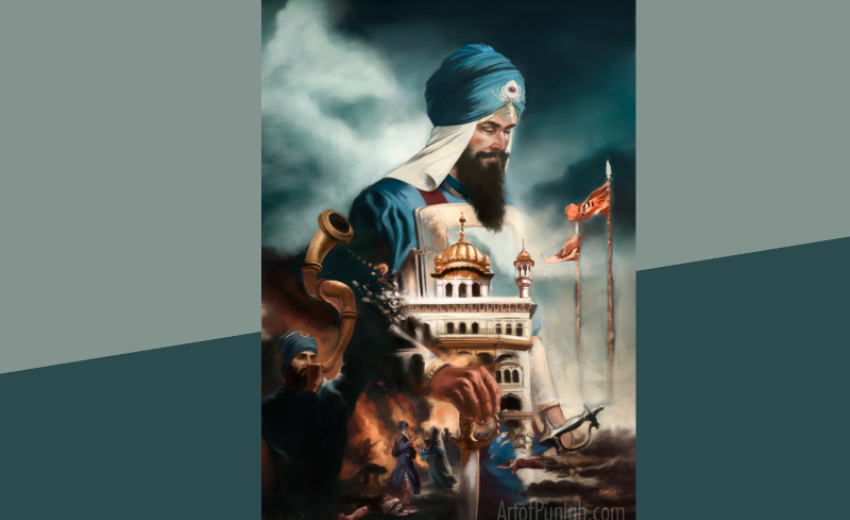Guru Hargobind, the sixth Sikh guru, founded the Sri Akal Takhat at age 11, following the martyrdom of his father 5th Guru Arjan Dev, son of 4th Guru Raam Daas and his wife Bibi Bhani, daughter of 3rd Guru Amar Daas.
Emperor Akbar gifted land to Bibi Bhani as a wedding present. Her husband Guru Raam Daas began excavation of a sarovar (water tank). Their son Guru Arjan completed the sarovar and built a gurdwara known as Harmandir Sahib to house the scriptures that he compiled known as the Adi Granth, or original scripture. Two years Guru Arjan achieved martyrdom after refusing to change a single work of the holy scriptures. His young son Guru Hargobind then erected the Sri Akal Takhat to face Harmandir Sahib establishing forever the spiritual and secular sovereignty of the Sikh nation.
Akal Takhat the Timeless Temporal Sikh Throne of Secular Sovereignty
To understand the true significance of “Akal Takhat” it helps to have an understanding of its meaning.
Akaal, commonly spelled Akal is a compound word composed of two parts. The root word is kaal meaning time, or death. With the prefix a, signifying “without”, the compound word a-kal comes to mean temporal, timeless, beyond time, immortal, everlasting, or eternal. Temporal is generally considered to refer to an in instance in an ever-present time, verses future or past. Temporal in the worldly sense is secular and so subordinate to the spiritual time frame of infinity.
Bunggaa, commonly spelled Bunga means “pavilion, or a dwelling atop at round tower with a cupola, or dome.”
Takht, commonly spelled Takhat, can mean “imperial throne, or seat of authority”.
Raising of the Akal Takhat and Akal Bunga
Differences in the measurement of time, various time zones, solar, and lunar calendars, including the Indian calendar Bikram Sambat Bk., Julian Calendar, or Common Era C.E., Gregorian Calendar A.D., and the controversial Nanakshai Calendar, creates difficulty establishing an exact timeline using modern dates. Using a fixed western calendar, the Guru Gaddi, or Guru Hargobind’s “Enthronement as Guru” is commemorated on June 16th.
During his coronation, the young Guru adorned his turban with a Kalgi (bejeweled plume), and donned two swords, one symbolizing Piri his spiritual sovereignty and the other symbolizing Miri his secular sovereignty. The Guru appointed 52 Sikhs as his personal body guard, raised a cavalry, mustered an army, and supplied them with weapons.
In the following days, assisted only by Baba Buddha and Bhai Gurdas, Guru Hargobind himself laid the cornerstone for a three and a half meter high (about 11.5’) platform atop a mound upon which he seated himself for audience with his followers. He did so in defiance of a decree declared by the Mughal emperor Jahangir, who had ordered his father’s martyrdom, which stated that no one dare sit higher than a single meter (about 3’ 9”) and named it the “Sri Akal Takhat”.
The Akal Takhat faced towards the Darbar Harmandir Sahib which housed the Adi Granth where worship services took place. A dwelling later erected atop the mound to house his throne was called the “Akal Bunga”. From here the Guru would hold audience with the sangat (congregation) to provide guidance on secular matters.
Over time the structure of the original Akal Bunga has been added to. Maharaja Ranjit Singh, who subjected himself to disciplinary measures by order of the Sri Akal Takhat, gave instructions for the building of and additional three stories to the original one.
Sri Akal Takhat sustained severe damage during Operation Blue Star, code name for the June 1984 Indian government attack on the Golden Temple complex. A renovation project in 1993 restored the Sri Akal Takhat to its current splendor.
Modern Day Sri Akal Takhat
Sri Akal Takhat stands directly across from, and faces, the Darbar Harmandir Sahib, meaning “Royal Court of the Temple of God, our Lord”, commonly known as the Golden Temple for its lustrous gold leaf overlay. The Darbar Sahib is situated in the center of the Sarovar, a large tank of water completely surrounded by a wide white marble walkway, or Parikrarma. Though the Darbar Sahib has 4 doors, one on each side, signifying all are welcome, there is but a single approach. A bridge spans the sarovar to the parikrama at the base of the Akal Takhat. The renovated Akal Takhat has five stories, each successively smaller than the last, topped by a golden dome.
Panj Takhat Five Temporal Seats of Authority.
Sri Akal Takhat is the original supreme seat of secular authority for all Sikhs. Edicts issued from the Akal Takhat apply to all who call themselves Sikh. No one individual Sikh regardless of rank, or any Sikh organization can ever be above the supreme authority of the Sri Akal Takat.
Sri Akal Takhat is located in Amritsar, India. Sri Akal Takhat is the first, and foremost, of the Panj (five) Takhat:
- Sri Akal Takhat Sahib, Amritsar, Punjab, India, originally called Akal Bunga.
Established 1906 by 7th Guru Hargobind. - Takhat Sri Kes Garh Sahib, District Roop Nagar Anandpur Sahib, Punjab, India.
Origin of the Panj Pyare, where 10th Guru Gobind Singh initiated the Khalsa on Vaisakhi 1699. - Takhat Sri Sach Khand Hazur Sahib, Abchal Nagar, Nanded Maharashtra, India.
Cremation site of 10th Guru Gobind Singh, built 1832–37 by instruction of Maharaja Ranjit Singh. - Takhat Sri Harmandir Sahib, Patna, Bihar, India.
Birthplace, and childhood residence, of 10th Guru Gobind Singh, built 1954–60. - Takhat Sri Damdama Sahib, Talwandi Sabo, District Bathinda, Punjab, India.
Declared Takhat 1966, here 10th Guru Gobind Singh revised & completed Siri Guru Granth Sahib.
Image by Kanwar Singh www.artofpunjab.com
